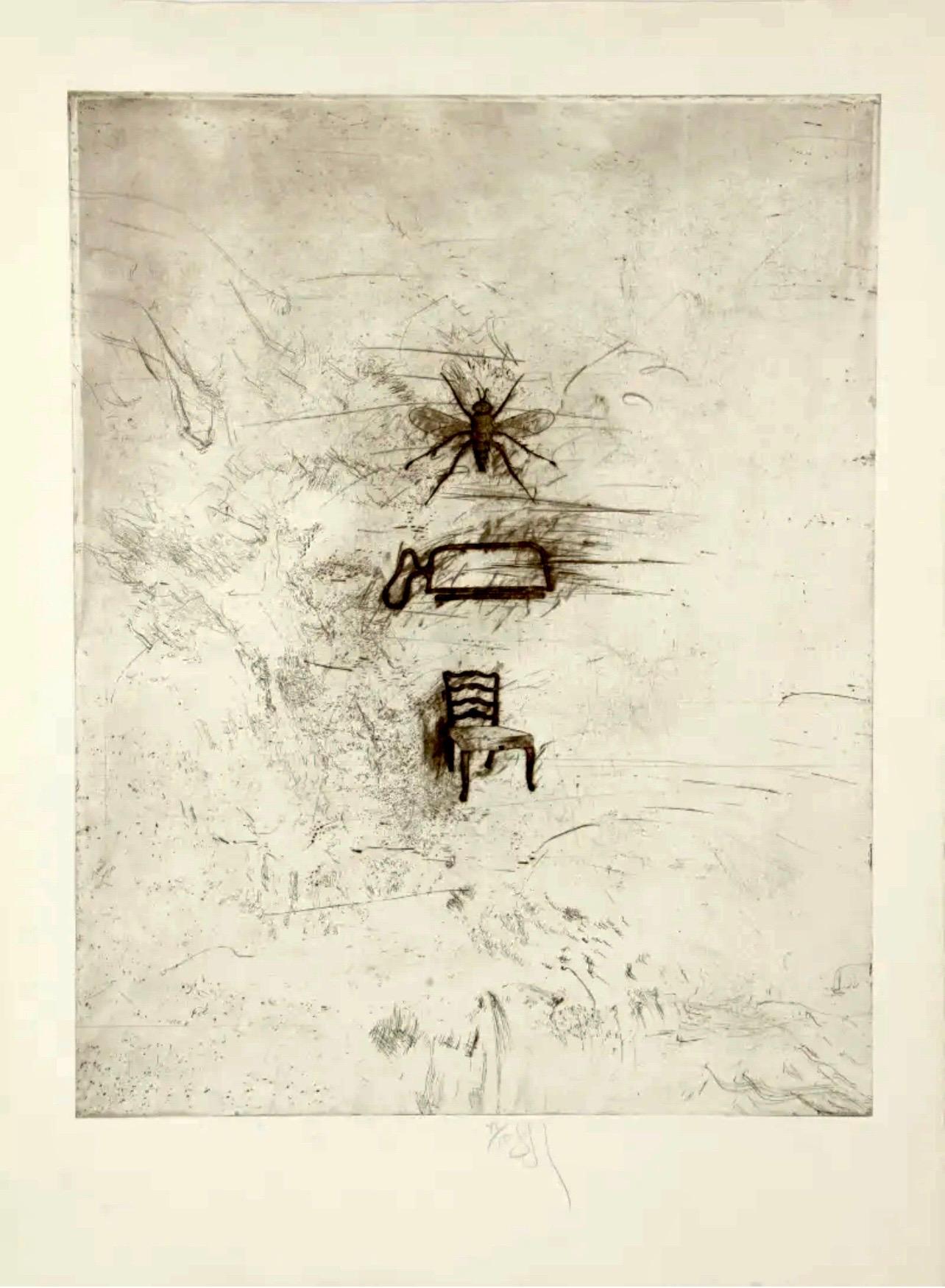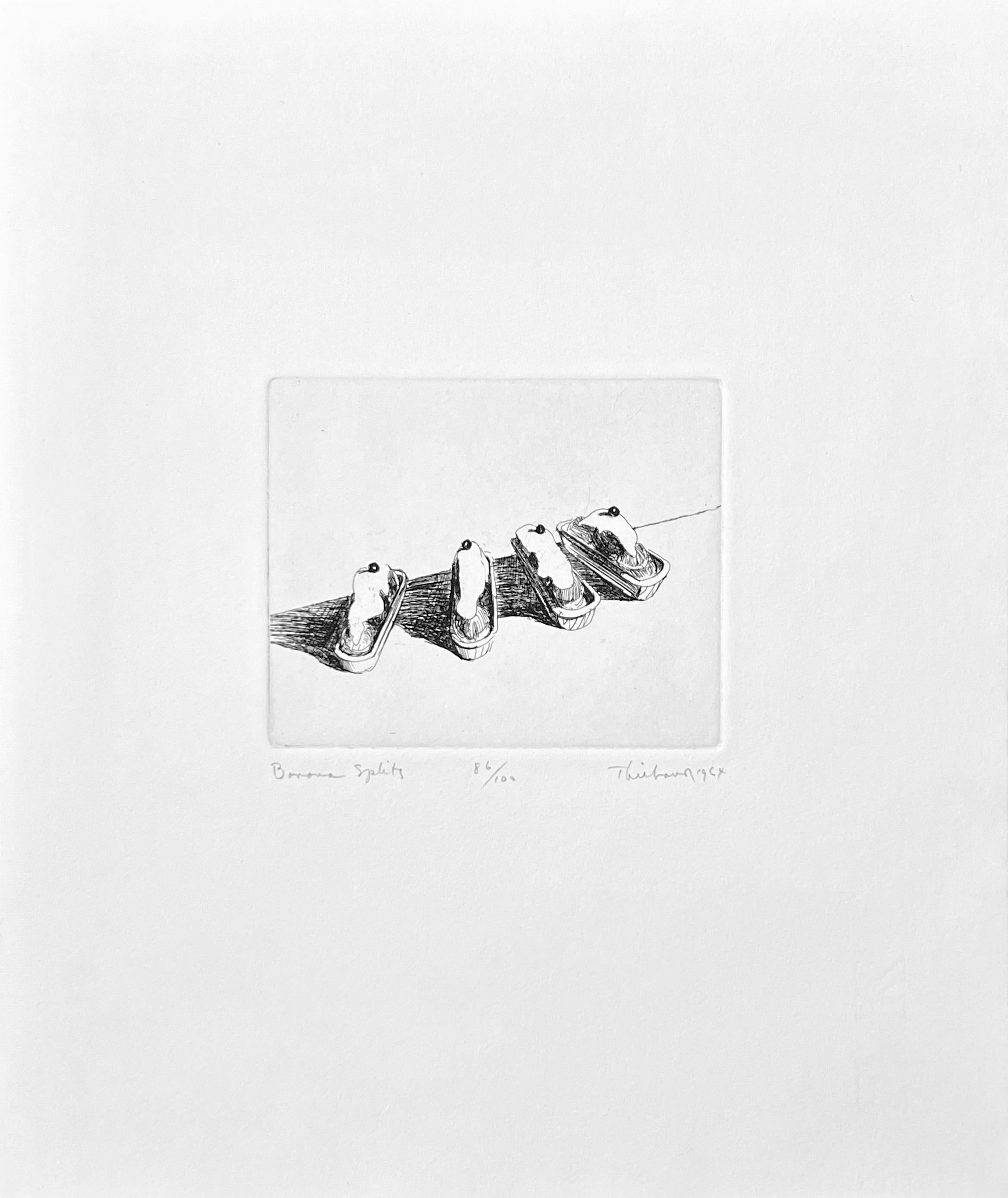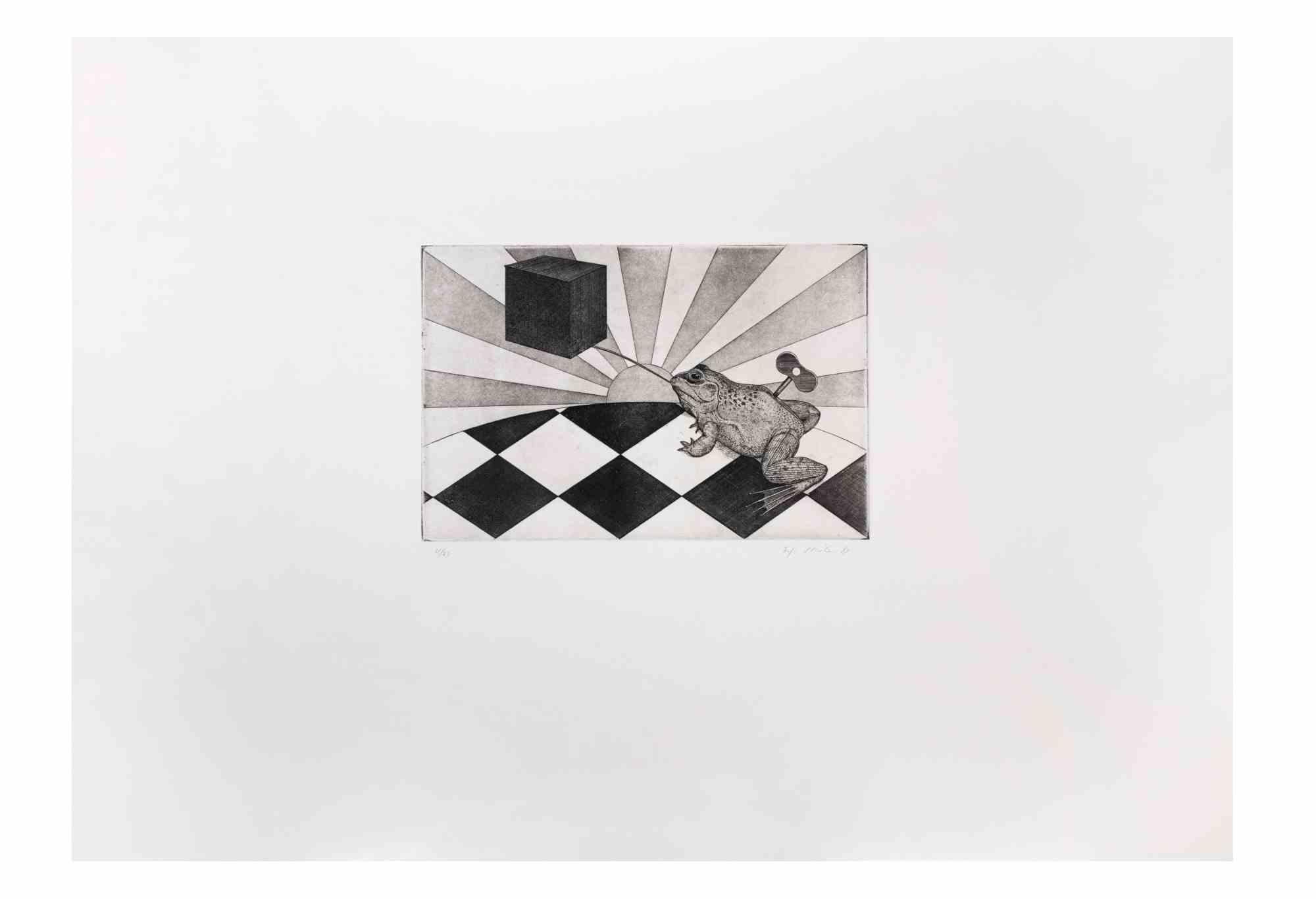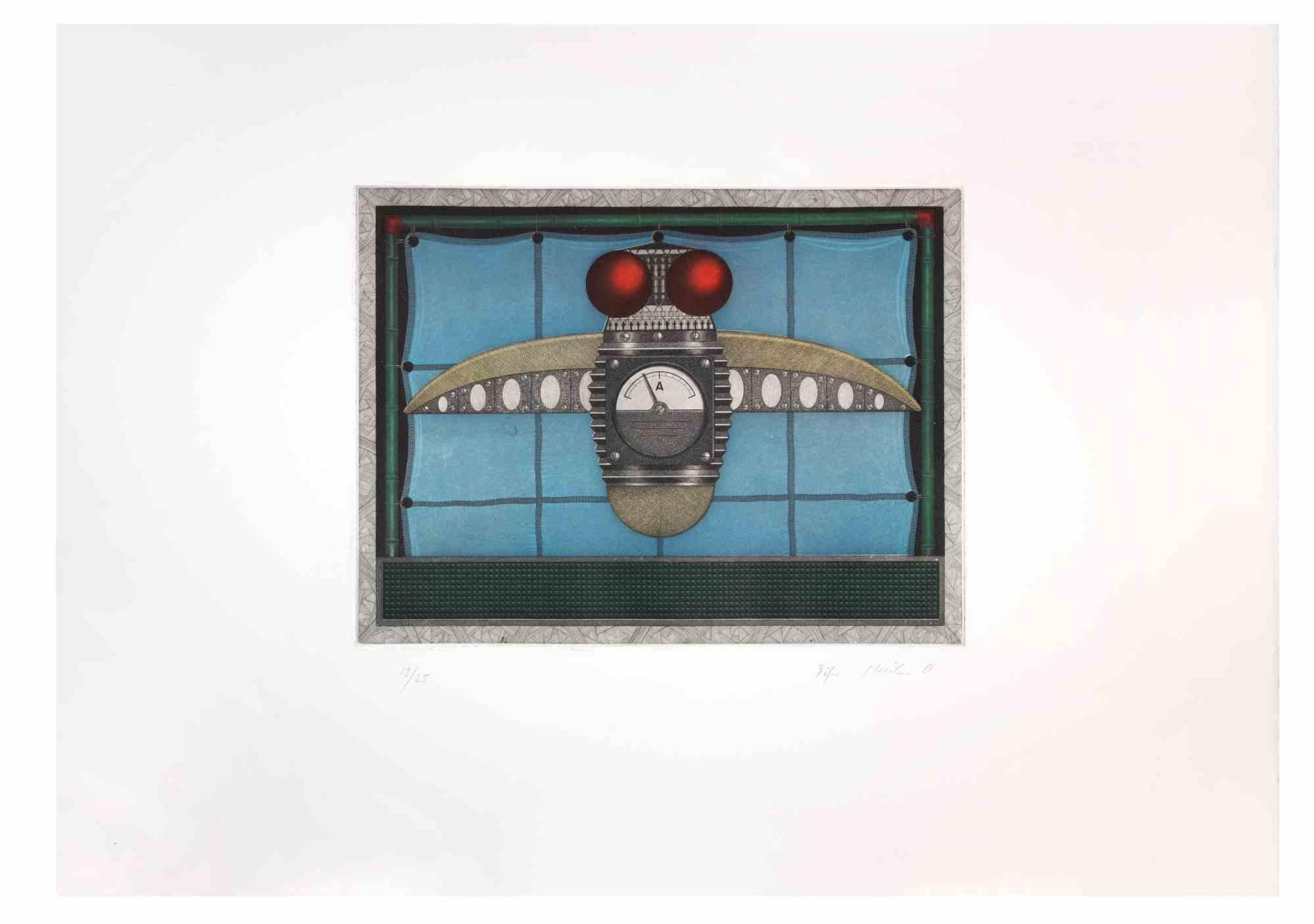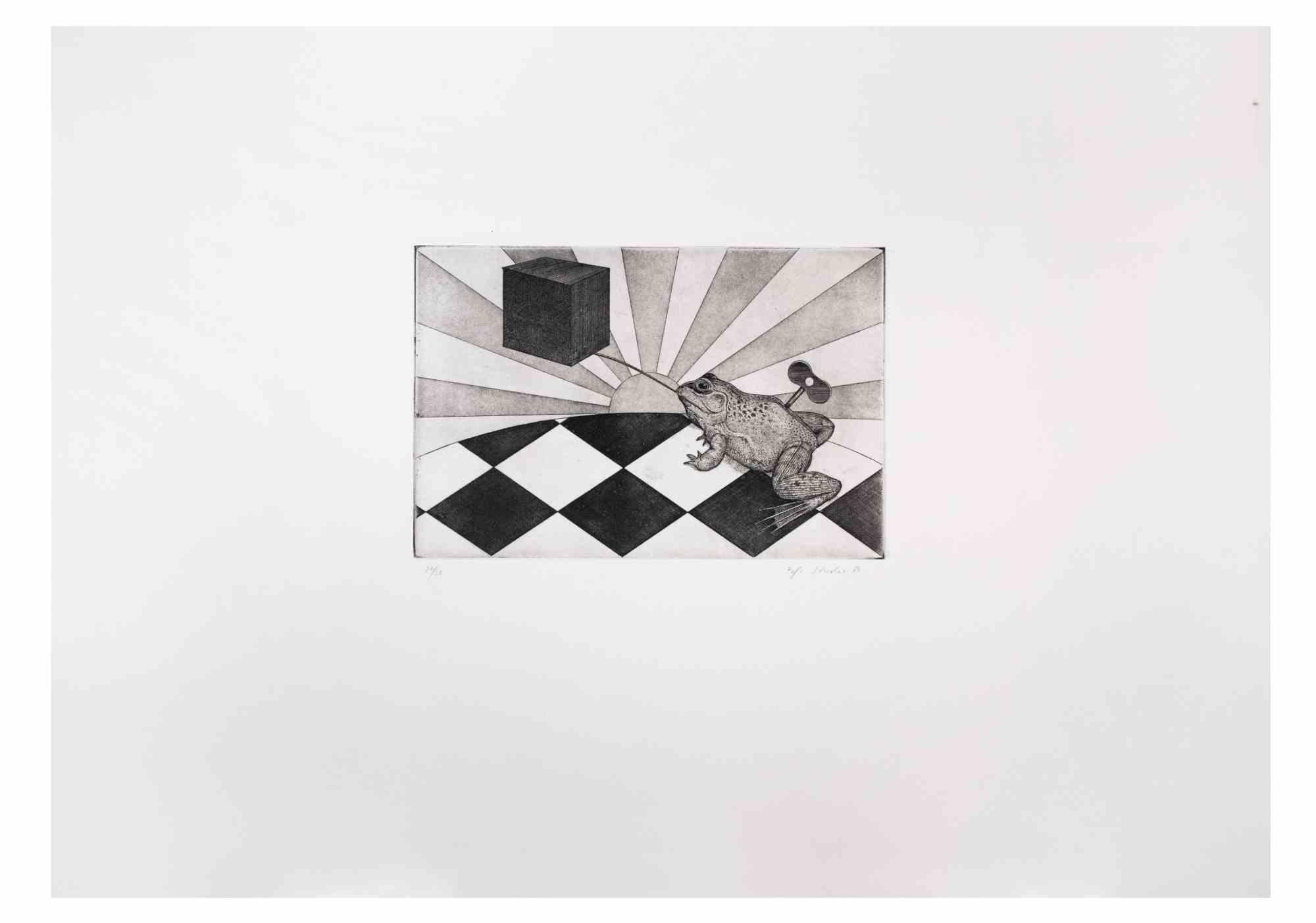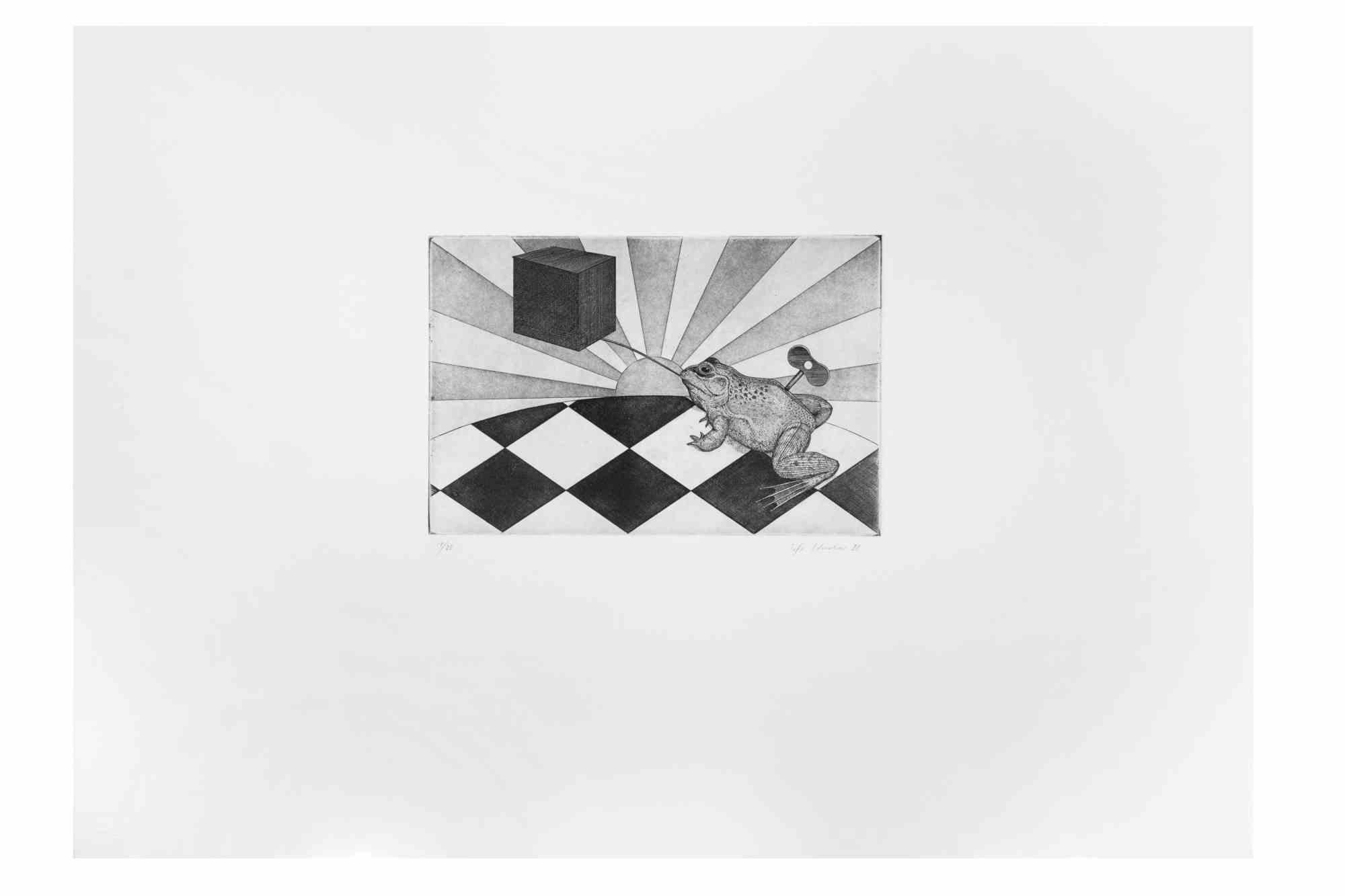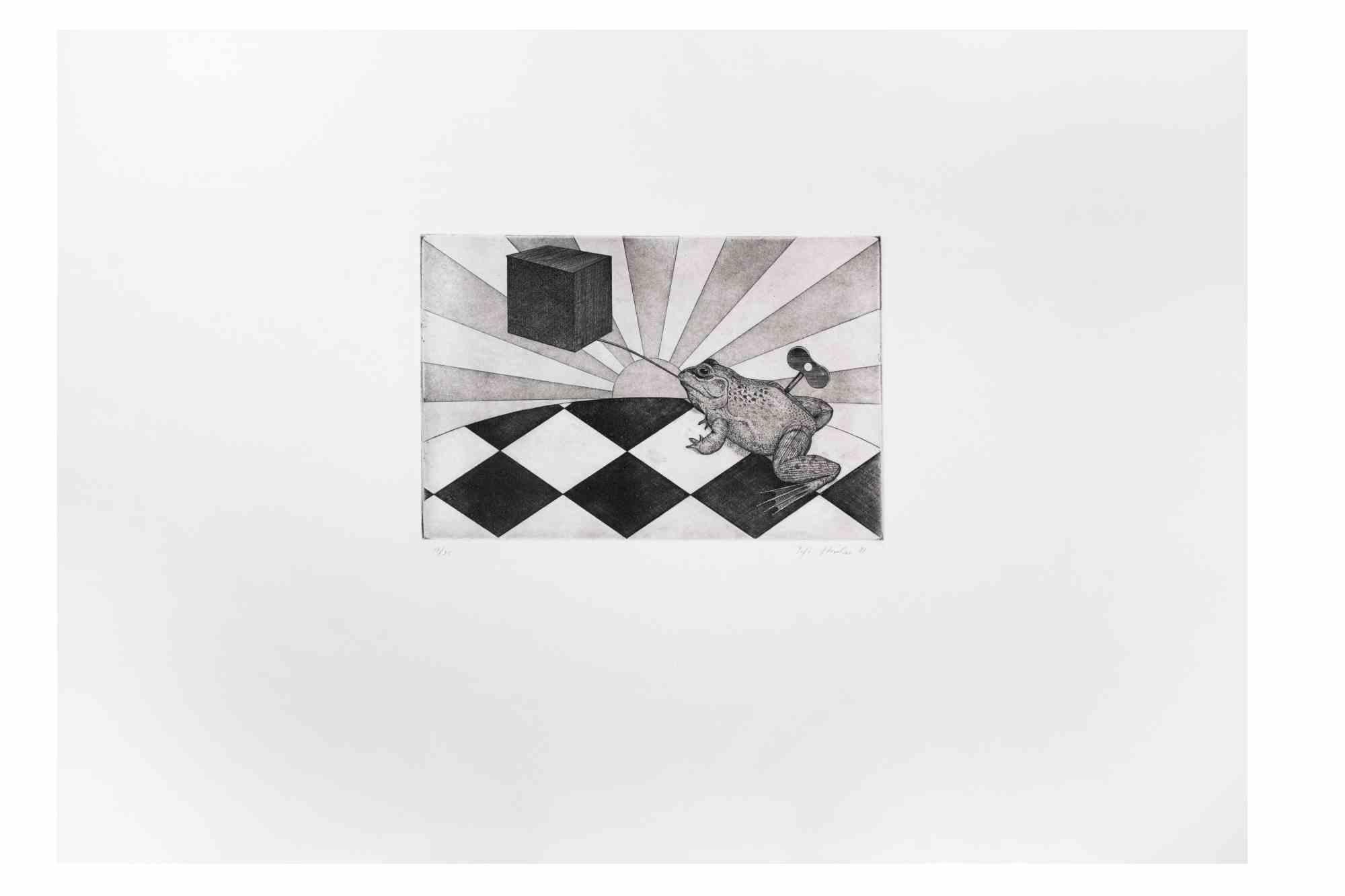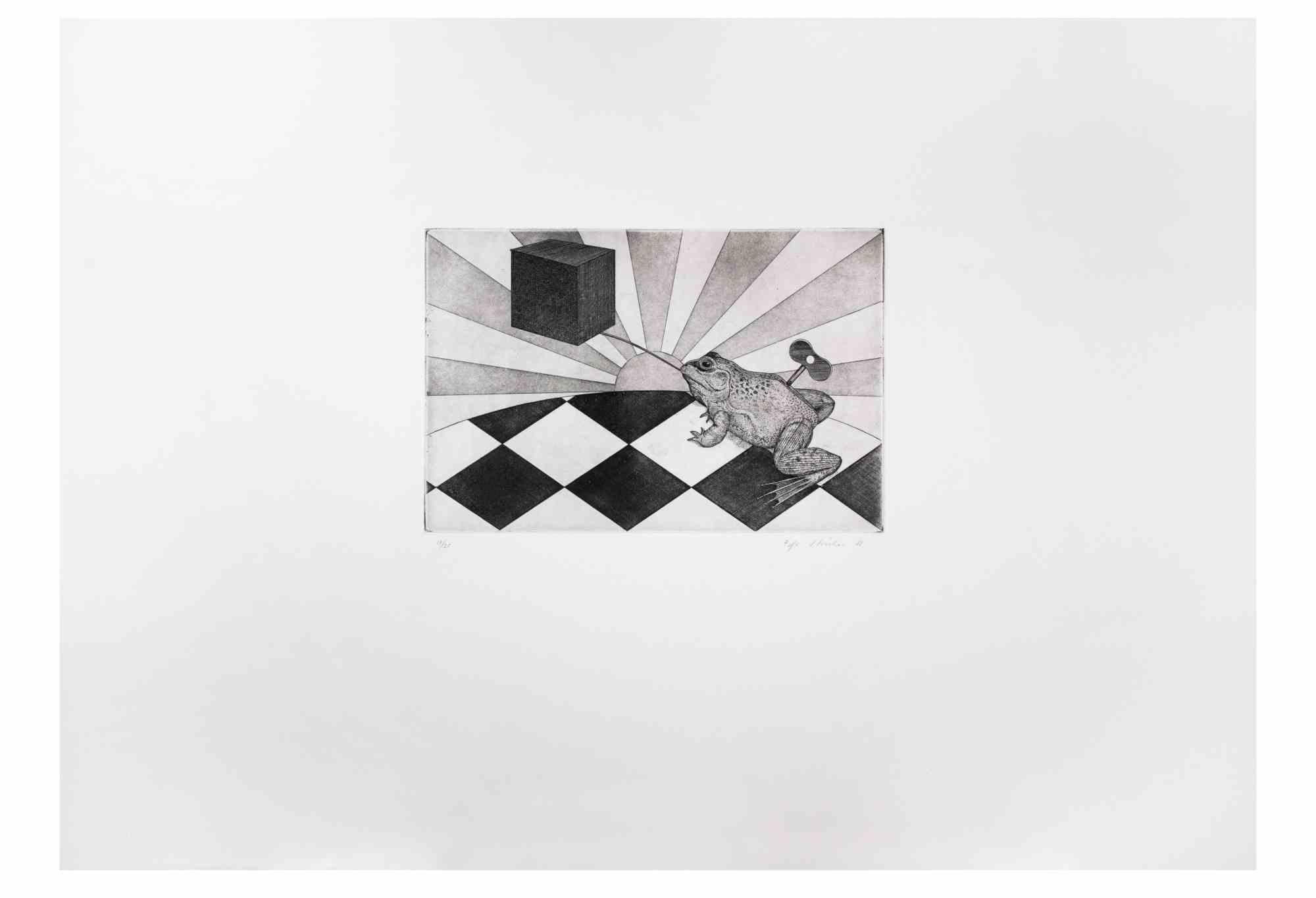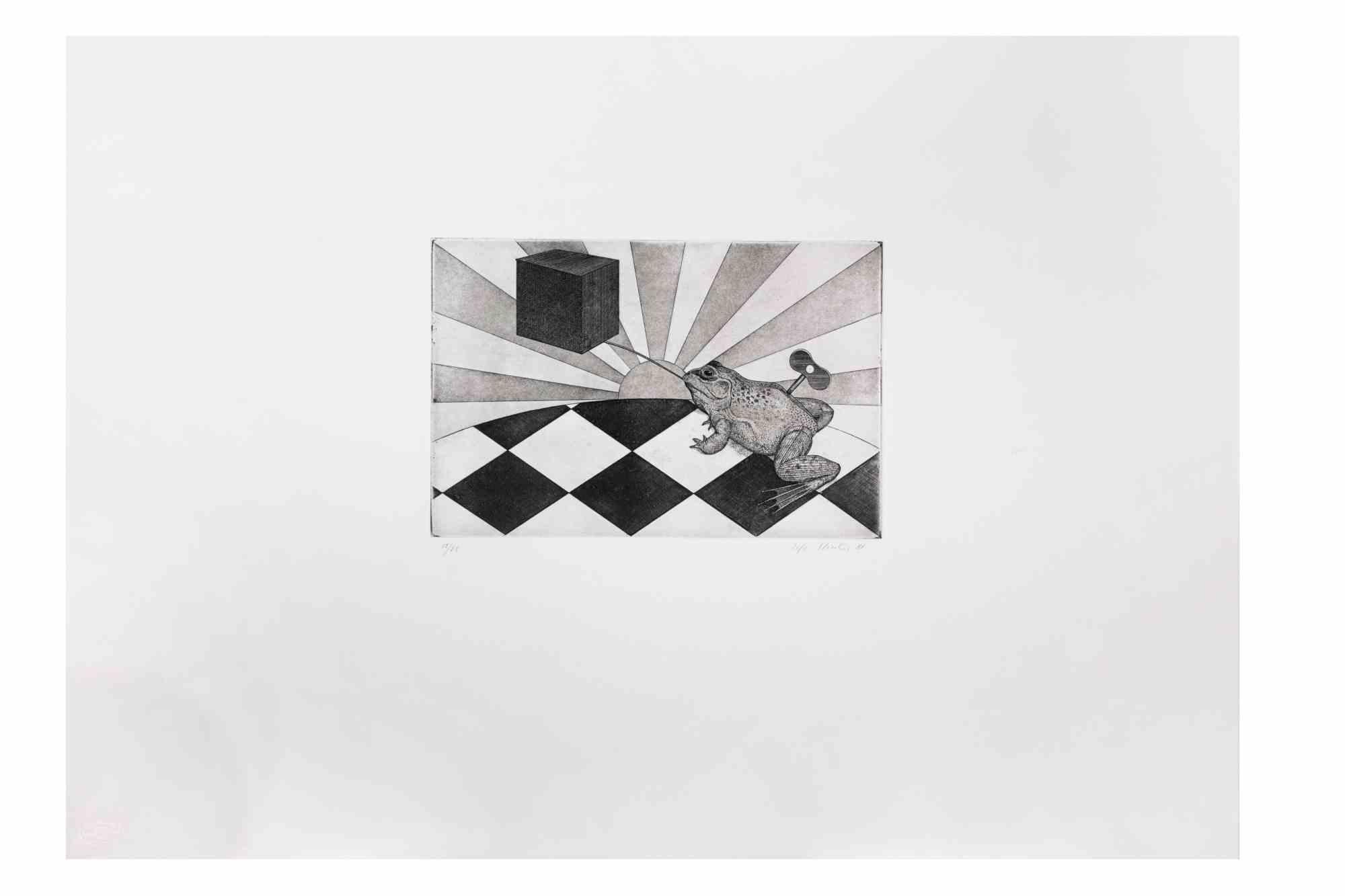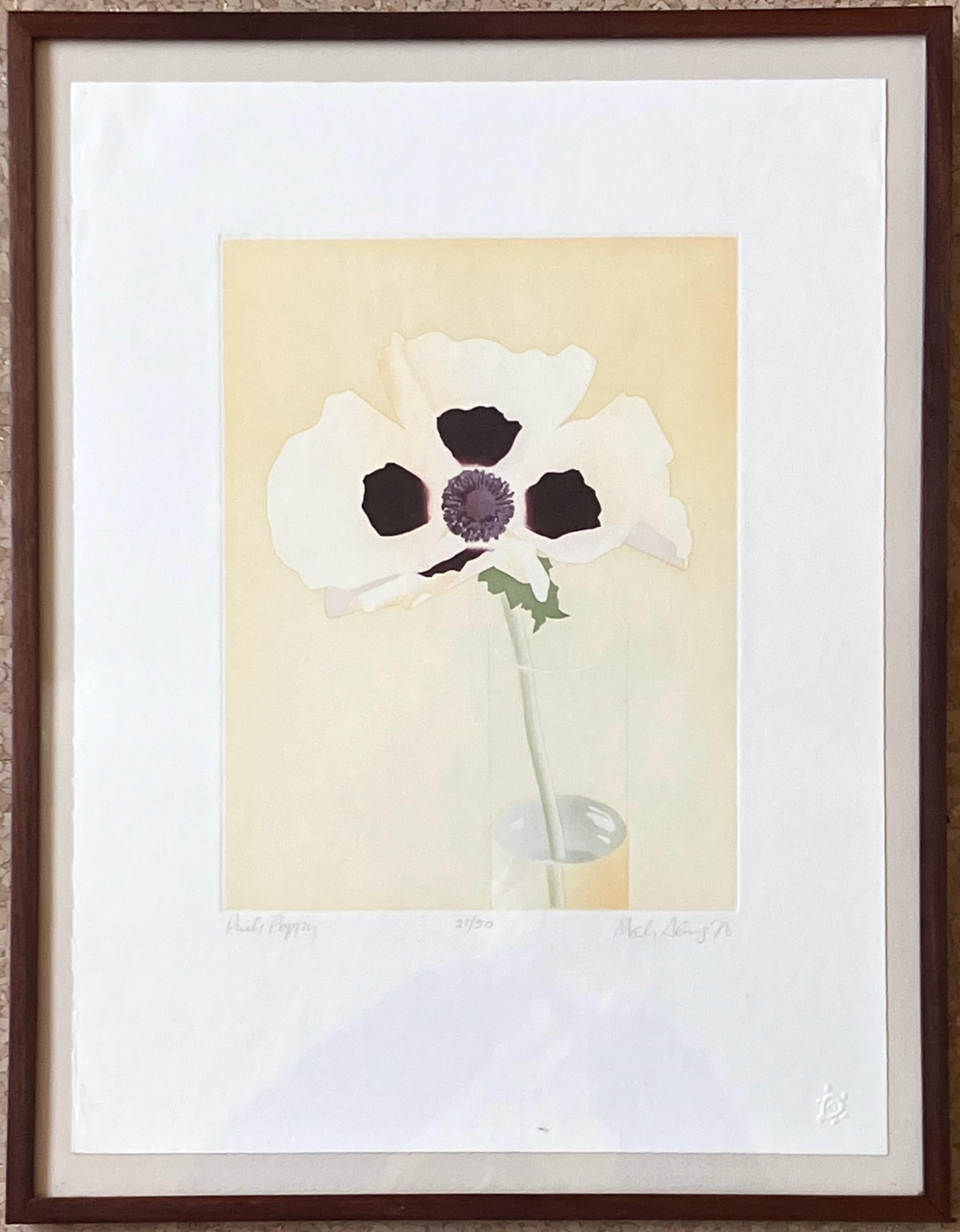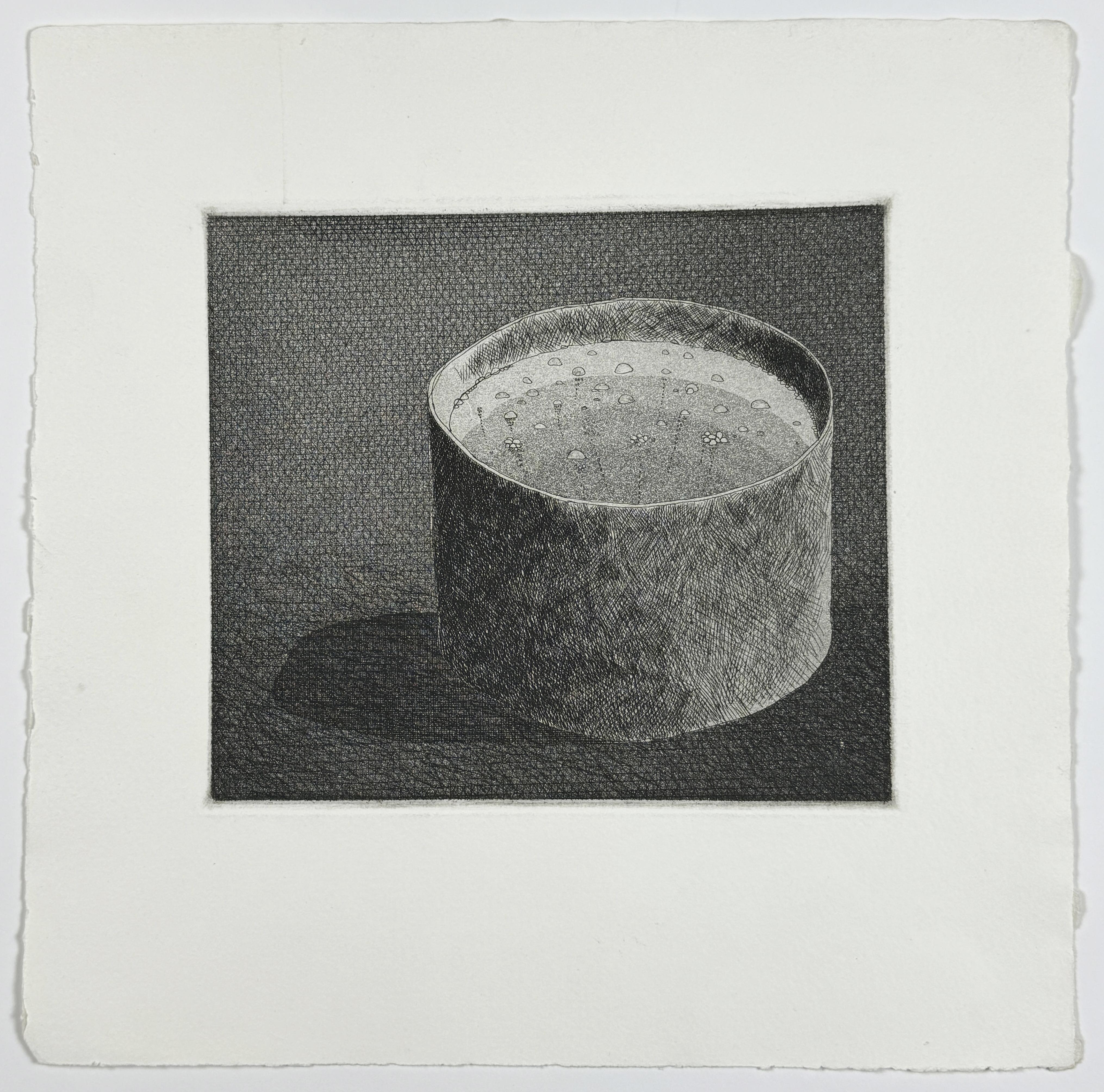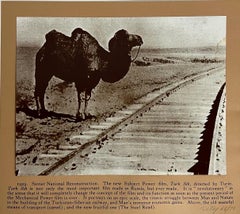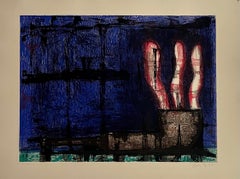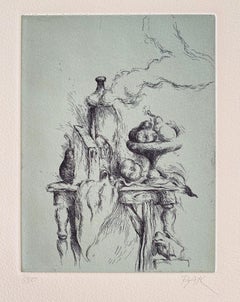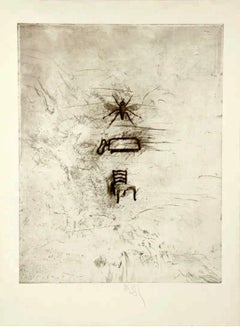
Large Donald Saff Surrealist Pop Art Aquatint Etching Bee, Chair, Pot
View Similar Items
Want more images or videos?
Request additional images or videos from the seller
1 of 10
Donald SaffLarge Donald Saff Surrealist Pop Art Aquatint Etching Bee, Chair, Potc.1980
c.1980
$900List Price
About the Item
- Creator:Donald Saff (1937, American)
- Creation Year:c.1980
- Dimensions:Height: 30 in (76.2 cm)Width: 22 in (55.88 cm)
- Medium:
- Movement & Style:
- Period:
- Condition:good. never framed.
- Gallery Location:Surfside, FL
- Reference Number:1stDibs: LU3829324942
About the Seller
4.9
Platinum Seller
Premium sellers with a 4.7+ rating and 24-hour response times
Established in 1995
1stDibs seller since 2014
1,795 sales on 1stDibs
Typical response time: 1 hour
Authenticity Guarantee
In the unlikely event there’s an issue with an item’s authenticity, contact us within 1 year for a full refund. DetailsMoney-Back Guarantee
If your item is not as described, is damaged in transit, or does not arrive, contact us within 7 days for a full refund. Details24-Hour Cancellation
You have a 24-hour grace period in which to reconsider your purchase, with no questions asked.Vetted Professional Sellers
Our world-class sellers must adhere to strict standards for service and quality, maintaining the integrity of our listings.Price-Match Guarantee
If you find that a seller listed the same item for a lower price elsewhere, we’ll match it.Trusted Global Delivery
Our best-in-class carrier network provides specialized shipping options worldwide, including custom delivery.More From This Seller
View AllLarge Donald Saff Surrealist Pop Art Aquatint Etching Bee, Chair, Pot
By Donald Saff
Located in Surfside, FL
Artist: Donald Saff
Medium: Etching with Aquatint, Hand signed and numbered in pencil
Donald Jay Saff (born 12 December 1937) is an artist, art historian, educator, and lecturer, sp...
Category
1980s Pop Art Figurative Prints
Materials
Etching, Aquatint
R.B. Kitaj Screenprint Collage Hand Signed British Pop Art Film Still Camel
By Ronald Brooks Kitaj
Located in Surfside, FL
The Most Important Film Ever Made, 1972
Color screen print and collage, from the edition of 70.
15 x 17 in
38.1 x 43.2 cm
Published by the artist with Marlborough Graphics at the Kelpra studio in 1972. This work is also in the collections of TATE London and the Victoria & Albert Museum. the price reflects the fact that there is no backing page.
Stylistically, these are hybrid works, influenced by Pop art and the modernist tradition of the Readymade, a work of art created when a mundane found object is named as an artwork and set in an art context. This avant-garde concept was originally invented by the Dada master Marcel Duchamp early in the twentieth century. In the 1960s it received renewed attention at a time when artistic norms were again being questioned. Reacting to Andy Warhol’s Pop imagery, Kitaj poignantly called his repurposed lithograph and silkscreen book covers “his soup can, his Liz Taylor.” The blatant use of images taken directly from commercial sources situates In Our Time as a precursor of appropriation art. In turning book covers into works of art, Kitaj is offering fragments of a history of knowledge, in which the content of each volume is at once mysterious and absent. Coming from this passionate bibliophile, the series is nothing less than an intellectual self-portrait.
R.B. Kitaj, in full Ronald Brooks Kitaj . Ron Kitaj...
Category
1960s Pop Art Still-life Prints
Materials
Screen
Boston Modernist Color Etching Smoking Pipe Aaron Fink Pop Art Print Americana
By Aaron Fink
Located in Surfside, FL
Aaron Fink (American, b. 1955)
Etching on paper titled "Untitled (Colored Pipe),"
Depicting an abstracted pipe with bright pink smoke floating from the bowl.
Hand signed in pencil...
Category
1980s Contemporary Figurative Prints
Materials
Etching
Samuel Bak Surrealist Etching Israeli Bezalel Artist "Hidden Pear", Fruit Bowl
By Samuel Bak
Located in Surfside, FL
HIDDEN PEAR, color etching, signed in pencil, numbered 7/50, Jerusalem Print workshop blind stamp, image 7 ½ x 5 ½”, sheet 15 x 10 ¼”.
Samuel Bak (born 12 August 1933) is a Polish- American painter and writer who survived the Holocaust and immigrated to Israel in 1948. Since 1993, he has lived in the United States.
Samuel Bak was born in Wilno, Poland, Bak was recognized from an early age as having an artistic talent. He describes his family as secular, but proud of their Jewish identity.
By 1939 when Bak was six years old, the war began and Wilno was transferred from Poland to Lithuania. When Wilno was occupied by the Germans on June 24, 1941, Bak and his family were forced to move into the ghetto. At the age of nine, he held his first exhibition inside the Ghetto. Bak and his mother sought refuge in a Benedictine convent where a Catholic nun named Maria Mikulska tried to help them. After returning to the ghetto, they were deported to a forced labour camp, but took shelter again in the convent where they remained in hiding until the end of the war.
By the end of the war, Samuel and his mother were the only members of his extensive family to survive. His father, Jonas, was shot by the Germans in July 1944, only a few days before Samuel's own liberation. As Bak described the situation, "when in 1944 the Soviets liberated us, we were two among two hundred of Vilna's survivors--from a community that had counted 70 or 80 thousand." Bak and his mother as pre-war Polish citizens were allowed to leave Soviet-occupied Wilno and travel to central Poland, at first settling briefly in Lodz. They soon left Poland and traveled into the American occupied zone of Germany. From 1945 to 1948, he and his mother lived in Displaced Persons camps in Germany. He spent most of this period at the Landsberg am Lech DP camp in Germany. It was there he painted a self-portrait shortly before repudiating his Bar Mitzvah ceremony. Bak also studied painting in Munich during this period, and painted "A Mother and Son", 1947, which evokes some of his dark memories of the Holocaust and escape from Soviet-occupied Poland. In 1948, Bak and his mother immigrated to Israel. In 1952, he studied art at the Bezalel Academy of Arts and Design in Jerusalem. After serving in the Israel Defense Forces, he continued his studies in Paris (from 1956 at the École nationale supérieure des Beaux-Arts) and spent various periods of time in Rome, Paris, Switzerland and Israel before settling permanently in the United States. In 2001, Bak returned to Vilnius for the first time and has since visited his hometown several times. Samuel Bak is a conceptual artist with elements of post-modernism as he employs different styles and visual vernaculars, i.e. surrealism (Salvador Dali, Rene Magritte), analytical cubism (Picasso), pop art (Andy Warhol, Roy Lichtenstein) and quotations from the old masters. The artist never paints direct scenes of mass death. Instead, he employs allegory, metaphor and certain artistic devices such as substitution: toys instead of the murdered children who played with them, books, instead of the people who read them. Further devices are quotations of iconographical prototypes, i.e. Michelangelo's "Creation of Adam" on the Sistine Ceiling or Albrecht Dürer's famous engraving entitled "Melencholia" . In the late 1980s Bak opened up about his paintings, stating they convey “a sense of a world that was shattered.” He turns these prototypes into ironical statements. Irony in the art of Samuel Bak does not mean parody or derision, but rather disenchantment, and the attempt to achieve distance from pain. Recurring symbols are: the Warsaw Ghetto Child, Crematorium Chimneys or vast backgrounds of Renaissance landscape that symbolize the indifference of the outside world. These form a disturbing contrast with the broken and damaged images in the foreground. Samuel Bak's paintings cause discomfort, they are a warning against complacency, a bulwark against collective amnesia with reference to all acts of barbarism, worldwide and throughout the ages, through his personal experience of genocide.
In Bak's piece entitled Trains Bak creates a vast grey landscape with large mounts creating the structure of a train. Massive taper candles burn in the distance further down the train tracks, surrounding an eruption. The smoke from the candles and volcano pour into a sky of dark ominous clouds that lurk over the landscape. Here Bak has created a whole new meaning for “trains.” Many of Bak’s pieces incorporate aspects of Jewish culture and the holocaust with a dark and creative twist, such as Shema Israel...
Category
20th Century Surrealist Figurative Prints
Materials
Etching
Zen Minimalist Flowers Etching American Modernist Ed Baynard Pop Art Print
By Ed Baynard
Located in Surfside, FL
ED BAYNARD (American, 1940-2016)
Flowers, Flowers in a Vase, Etching.
1979/1980,
Hand signed, dated l.r.,
Hand numbered from small edition 12/24,
Dimensions: 23 by 19 in. Framed 25 by 21 in
Born in Washington, D.C. in 1940. Raised in Washington, D.C. and newly graduated from high school, he flew to Europe living off and on in Paris and London. During this time, he designed costumes for Jimi Hendrix, worked as a graphic designer for the Beatles as well as Elizabeth Taylor and Richard Burton. Returning to New York, he dedicated his life to art after a surprise success with his first show in 1971 at the Willard Gallery in NYC. Ed's images are Zen-like in their simplicity and grace rendered in a flat, graphic style that recalls Japanese Ukiyo-e prints. His watercolors are luminous, like the rest of his representations regardless of the medium. The Japanese inspired ukiyo-e style woodblock prints and lithograph works he created at Tyler Graphics in 1980 contain a 20th century "floating world" sensibility. Ed's wish was to bring harmony, color, and a meditative stillness to this chaotic planet. He did so in a gentle and powerful way, always as an expression of his deep gratitude for the love and beauty, friendship, and concerns he held dearest. His first solo exhibition was in 1971 at New York's legendary Willard Gallery on the recommendation of Agnes Martin. Baynard went on to have exhibitions at galleries including Betty Parsons Gallery, New York (1973); Marian Goodman Gallery, New York (1977); John Berggruen Gallery, San Francisco (1980); and Barbara Gladstone Gallery, New York (1980/81).. Baynard manages to retain a simplicity of form inspired by a love of Japanese Woodblock prints. His new works reflect the same poetry of his earlier paintings, retaining his stylized compositions with their Zen like minimalism and Oriental calm, along with a new sense of rhythm and movement. Baynard uses familiar themes such as flowers, plants, pots, and vases, incorporating them into his delicate watercolor still lifes, thus creating stunning visual feasts. He was included in the 1972 Landscape exhibition at MoMA NY alone with other luminaries James Boynton...
Category
1980s American Modern Still-life Prints
Materials
Etching
Zen Minimalist Flowers Etching American Modernist Ed Baynard Pop Art Print
By Ed Baynard
Located in Surfside, FL
ED BAYNARD (American, 1940-2016)
Flowers, Flowers in a Vase, Etching.
1979/1980,
Hand signed, dated l.r.,
Hand numbered from small edition 12/24,
Dimensions: 23 by 19 in. Framed 25 by 21 in
Born in Washington, D.C. in 1940. Raised in Washington, D.C. and newly graduated from high school, he flew to Europe living off and on in Paris and London. During this time, he designed costumes for Jimi Hendrix, worked as a graphic designer for the Beatles as well as Elizabeth Taylor and Richard Burton. Returning to New York, he dedicated his life to art after a surprise success with his first show in 1971 at the Willard Gallery in NYC. Ed's images are Zen-like in their simplicity and grace rendered in a flat, graphic style that recalls Japanese Ukiyo-e prints. His watercolors are luminous, like the rest of his representations regardless of the medium. The Japanese inspired ukiyo-e style woodblock prints and lithograph works he created at Tyler Graphics in 1980 contain a 20th century "floating world" sensibility. Ed's wish was to bring harmony, color, and a meditative stillness to this chaotic planet. He did so in a gentle and powerful way, always as an expression of his deep gratitude for the love and beauty, friendship, and concerns he held dearest. His first solo exhibition was in 1971 at New York's legendary Willard Gallery on the recommendation of Agnes Martin. Baynard went on to have exhibitions at galleries including Betty Parsons Gallery, New York (1973); Marian Goodman Gallery, New York (1977); John Berggruen Gallery, San Francisco (1980); and Barbara Gladstone Gallery, New York (1980/81).. Baynard manages to retain a simplicity of form inspired by a love of Japanese Woodblock prints. His new works reflect the same poetry of his earlier paintings, retaining his stylized compositions with their Zen like minimalism and Oriental calm, along with a new sense of rhythm and movement. Baynard uses familiar themes such as flowers, plants, pots, and vases, incorporating them into his delicate watercolor still lifes, thus creating stunning visual feasts. He was included in the 1972 Landscape exhibition at MoMA NY alone with other luminaries James Boynton...
Category
1980s American Modern Still-life Prints
Materials
Etching
You May Also Like
Banana Splits
By Wayne Thiebaud
Located in New York, NY
Included in the artist’s early, renowned Delights suite, Wayne Thiebaud created Banana Splits in 1964 as an original etching, the artwork hand-signed, titled, dated and numbered in p...
Category
20th Century Pop Art Figurative Prints
Materials
Etching
Price Upon Request
Pomegranates
By Kaiko Moti
Located in San Francisco, CA
This artwork titled "Pomegranates" c.1970 is an original color aquatint on Japan paper by noted Indian artist Kaiko Moti, 1921-1989. It is hand signed and numbered XXII/LXXV in White pencil by the artist. The Size is 22 x 29.25 inches. Printed to the edge. It is in excellent condition, some hanging tape remaining on the back from a previous framing.
About the artist:
Born (Kaikobad Motiwalla) in Bombay, India on December 15, 1921, Moti was first educated at the Bombay School of Fine Arts but his talent led him onwards to study at the University College in London (on scholarship) and at the Slade School of Fine Arts, London, where he received a Master's degree in Painting and Sculpture. While still in London he studied under MacWilliam and Reginald Butler.
Eventually moving to Paris in 1950, Moti attended the Academie de la Grand Chaumiere, Atelier Zadkine, to pursue his love of sculpture but lack of space soon compelled him to turn his attention to working on copper plates and he studied engraving with William Stanley Hayter...
Category
Mid-20th Century Impressionist Still-life Prints
Materials
Aquatint
Weightlifter - Aquatint and Etching by Fifo Stricker - 1981
Located in Roma, IT
Weightlifter is a contemporary artwork realized by the artist Fifo Stricker in 1981.
Mixed colored aquatint and etching. Original title: Gewichtheber
Category
1980s Contemporary Still-life Prints
Materials
Aquatint, Etching
Insekt I - Aquatint and Etching by Fifo Stricker - 1981
Located in Roma, IT
Insect I is a contemporary artwork realized by the artist Fifo Stricker in 1981.
Mixed colored aquatint and etching.
Hand signed and dated by the artist on the lower right margin....
Category
1980s Contemporary Still-life Prints
Materials
Aquatint, Etching
Weightlifter - Aquatint and Etching by Fifo Stricker - 1981
Located in Roma, IT
Weightlifter is a contemporary artwork realized by the artist Fifo Stricker in 1981.
Mixed colored aquatint and etching. Original title: Gewichtheber
Category
1980s Contemporary Still-life Prints
Materials
Aquatint, Etching
Weightlifter - Aquatint and Etching by Fifo Stricker - 1981
Located in Roma, IT
Weightlifter is a contemporary artwork realized by the artist Fifo Stricker in 1981.
Mixed colored aquatint and etching. Original title: Gewichtheber
Category
1980s Contemporary Still-life Prints
Materials
Aquatint, Etching
Recently Viewed
View AllMore Ways To Browse
English Renaissance Chair
Gravity Clock
Pour Roby Etching By Pablo Picasso
Pour Roby
Renoir Maternite
Ricordi Portfolio
Rie Munoz
Robert Bane
Rockin Jelly Bean
Roger Hebbelinck
Rudolf Lesch
Sable Mouvant
Sadao Watanabe. On Sale
Salvador Dali Aliyah Lithograph
Salvador Dali Aliyah
Salvador Dali Icarus
Salvador Dali Jesus On The Cross
Salvador Dali Last Supper
